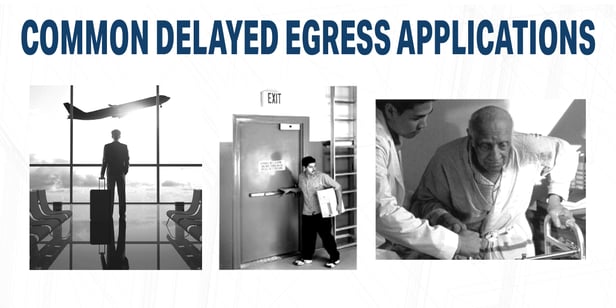 This post is the third in a series to address concerns expressed on our social media platforms regarding Delayed Egress Systems that indicated misconceptions about their proper application in Security, and Fire and Life Safety applications. Here’s some information and examples of common applications of Delayed Egress Systems.
This post is the third in a series to address concerns expressed on our social media platforms regarding Delayed Egress Systems that indicated misconceptions about their proper application in Security, and Fire and Life Safety applications. Here’s some information and examples of common applications of Delayed Egress Systems.
Common Applications: Pedestrian Traffic Control and Theft Protection
As we said in prior posts, Delayed Egress systems are used to control pedestrian traffic in government, public and transportation facilities, including airport jetways and tarmacs. The purpose is usually to “prevent unauthorized access/egress and to control and limit traffic effectively in designated areas.”[1]
Chances are, you’ve probably heard a door alarm, siren, or audible alert message at an airport when someone tried to enter or exit a terminal door enabled with a Delayed Egress lock.

[1] From “Electronic Locking Systems” by John L. Schum: Considered to be the Industry Bible for Electronic-Electric Locks - https://www.amazon.com/Electronic-Locking-Devices-Security-Technicians/dp/0409901253
Delayed Egress Systems provide protection against theft and destruction of merchandise, technology and other valuables such as art and museum artifacts in stores, warehouses, art galleries, museums and technology facilities.
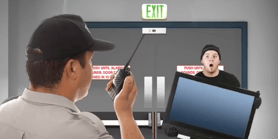
Some great Delayed Egress application examples can be found in a Delayed Egress Traffic Control Solution flyer featuring our 1581S Series Mini Integrated Delayed Egress Locks (click here) or a Delayed Egress High Traffic Control solution featuring our 1511S Series Integrated Delayed Egress Locks found on page 28 of our Access Control Security Solutions brochure (click here).
Common Applications: Wandering Patients and Infant Protection
Delayed Egress locks also restrict movement of wandering patients in senior assisted living, psychiatric, and drug rehab facilities and guard against infant abduction in hospital nurseries.
 Having a controlled environment to serve the special needs of Dementia/Alzheimer patients is critical to their care. Delayed Egress Systems allow freedom of movement while protecting wandering patients from dangerous elopement situations. And, they can be compatible with popular patient tracking systems like those used in nurseries to deter kidnapping of infants.
Having a controlled environment to serve the special needs of Dementia/Alzheimer patients is critical to their care. Delayed Egress Systems allow freedom of movement while protecting wandering patients from dangerous elopement situations. And, they can be compatible with popular patient tracking systems like those used in nurseries to deter kidnapping of infants.
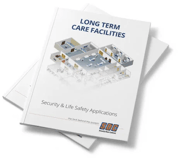
Check out our Long Term Care Facility Solution flyer for a quick Delayed Egress application example (click here), visit our LTC Facilities page at https://sdcsecurity.com/LTCFacilities.htm for more Delayed Egress locking applications, or download our Long Term Care Facilities brochure (click here) with additional solutions.
Proper Application Must Comply With Codes
A Delayed Egress System must comply with all national and regional building and fire life safety codes and the NFPA 101 section on Special Locking Arrangements. Some common requirements are:
- The delayed egress lock must be approved or listed and shall be permitted for installation on doors
serving occupancy levels as specified per prevailing code (consult your AHJ for complete details). - The doors must unlock upon activation of an automatic sprinkler system or automatic fire detection
system. - The door(s) must unlock upon loss of power controlling the delayed egress locking device.
- The delayed egress locks shall be unlocked by a signal from the fire command center.
- Applying no more than 15 lbs of pressure will start an irreversible process to unlock the door.
Nuisance delay varies per code. - An alarm must sound at the opening upon initiation of the release process.
- A sign must be applied to the door.
Here’s a brief summary of how door opening code compliance applies to some of SDC’s most popular Delayed Egress Solutions:
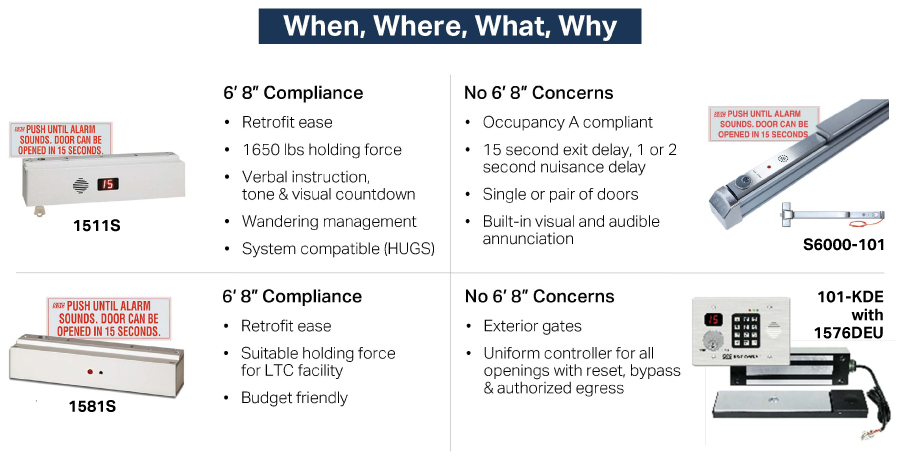
Finally, download this flyer (click here) for a more comprehensive list of Code Compliant Operation Modes that apply to our Delayed Egress Systems.
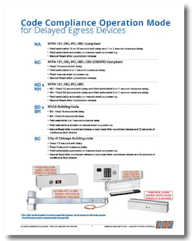
As always, we strongly recommend checking with the local AHJ regarding code compliance before considering or installing any type of Delayed Egress System to ensure the proper application will meet your specific requirements.
And, visit our own Delayed Egress Innovation page at: www.sdcsec.com/delayedegress

